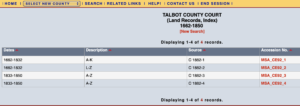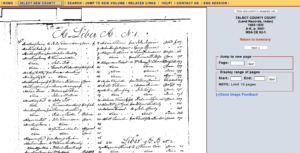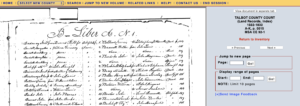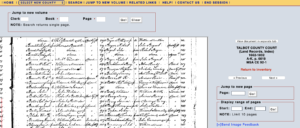I certainly did not until I bumped into Noah Willis who married Eliza Blake on 31 Jan 1827 in Talbot County, Maryland. He appears three years later in the 1830 census for Talbot heading a household of a whopping 16 people. What gives?
Thanks to detailed records at FamilySearch.org, the Maryland State Archives Online, and at MDLANDREC.net, we can answer many questions about this man and his descendants. The record reveals that he was born in Maryland, but not his family of origin.[1] We have no clue about his parents and cannot connect him to my ongoing project identifying descendants of “Wantage John” Willis who died 1712 in Dorchester County, Maryland.
But let’s go back … what does the record show about Noah?
First, there is his marriage in 1827 to Eliza Blake.[2] Then, there is the 1830 census for Talbot that shows the following household residents:
- Seven white boys – 1 male under 5 years, 3 males age 5-9, 3 males 10-14,
- Two white men – 1 male 30-39, and 1 male 40-49
- One white girl – 1 female under 5
- One white woman – 1 female 30-39
- One free black woman -1 female age 10-23
- Two enslaved girls – 2 females under 10
- One enslaved teenage girl – 1 female age 10-23
- One enslaved woman – 1 female 24-35
Further investigation shows Eliza had been married before and Noah may have been. Noah Willis at age 26 to 44 appears in the 1820 census for Talbot County with a woman age 45+, presumably his wife but maybe his mother or sister. The remainder of that household are 43 enslaved people … 16 males and 27 females, with 17 members of the household employed in agriculture. I have not identified the woman in Noah’s household, but there were no children. Furthermore, the woman disappeared before Noah married Eliza in 1827, or at least before the census in 1830.
Talbot County deed records show Noah purchased 140 acres of land in 1823.[3] Likely, he was renting and farming that same land at the date of the 1820 census. He sold that land in 1828 after his marriage to Eliza, and they lived on her property.[4]
As to Eliza’s first marriage, on 20 Nov 1816 Eliza Ray wed John Blake.[5] The 1820 census lists the Blake household near the Willis lands. It shows John Blake and his wife both at age 18-25 with three children, a girl age 10-18 and two boys less than 10.[6] The rest of the household consists of 8 enslaved males and 9 enslaved females. John Wilson Blake purchased more than 400 acres of land in 1821 in the Miles River Neck for $10,500, entering into a fifteen-year mortgage for about half of that amount.[7] The Blake couple had three more sons before John died intestate in 1826 leaving his widow and six orphan children.[8]
In 1828, Samuel Roberts, administrator of the estate of John W. Blake, deceased, began filing annual reports as acting guardian of Blake’s six orphan children … five boys and a girl, naming each one.[9] His reports include an item of expense for each child as “Board and clothing paid to Noah Willis.” Obviously, these six children are in the Willis household in the 1830 census. The personal property attributable to each orphan is a one-sixth share of the annual rent derived from the land owned by their deceased father (net of their mother’s dower). Eliza Blake Willis nee Ray is clearly the mother of these children.[10] In about 1828, Eliza gave birth to a son by Noah, James Willis. With this information we can name all of the white occupants of the household except one man and one boy, whom we can reasonably assume are related to Noah or Eliza, possibly her brother and his child:[11]
- Noah Willis – age 40-49
- Unidentified male – 30-39
- William Blake, John Blake, Theodore Blake – 10-14
- Richard Blake, Thomas Blake, unidentified boy – 5-9
- James Willis – under 5
- Eliza Ray Blake Willis – 30-39
- Mary Ann Blake – under 5
Talbot County guardian accounts show that from 1833 through 1836, Noah Willis served as guardian of the six children. I am uncertain why Samuel Roberts vacated that office. Appraisers periodically assessed the real estate of the deceased John W. Blake and submitted to the Orphan’s Court a fair annual rental for the property. The property descended through the laws of intestate descent and distribution to Blake’s orphan children, subject to their mother’s rights during her lifetime. The Willis family occupied the property and Noah Willis “rented” it from the estate. Had a third party occupied and rented the farm, an arms-length transaction would have established the value and the annual rental. However, Noah’s renting the farm necessitated the third-party appraisals. Noah’s guardian accounts dutifully tabulated each orphan’s one-sixth share of the rental income (after dower). The deducted expenses attributable to each child were a share of taxes and filing fees, with the difference between income and those expenses listed as the cost of boarding and clothing the child. Therefore, the resulting balance due each child was zero. Noah “paid” rent into the guardian account and then “paid” himself from the account for caring for the children, so no money really changed hands except for the taxes and fees paid to the county.
The appraisal process established an annual rental of $400 in 1831, $350 in 1834, and $275 in 1836. The record shows a detailed description of the land and improvements.[12] The land amounted to about 430 acres of which 200 was forested. The rest was arable with the soil ranging from very good to thin. The farm had three fields. The first contained 220,000 hills of corn, and the other two about 140,000 to 150,000 hills. Two apple orchards existed. The older one with 152 trees was in a bad state of decay; the second with 50 trees thrived. A fenced vegetable garden was under a new rail fence, strong and good.
The appraisers described the farms buildings in this manner, a “frame house with two good rooms and a passage and stair case on the first floor and three rooms above, good cellars, a good brick lodging room adjoining and a good brick kitchen. All these are in pretty good repair. A good frame smoke house about 12 feet square, a good corn house of about 12 by 24 feet, and four other out houses, such as poultry houses, a stable and quarters, all wretchedly dilapidated. There is a large barn of about 60 by 28 feet, good frame but suffers for want of a good roof. There is also the roof of a corn house, quite good, but no house or underpart. This roof is about 50 or 60 feet long. The fencing on the farm is tolerably good, but the general state of the farm is somewhat out of order.”
Noah and Eliza had two more children, Margaret (who died an infant) and Eliza A., before Noah Willis died about 1837. On 31 May 1838, Noah’s widow married William T. Stitchberry in Talbot County.[13] She and Stitchberry entered into a prenuptial agreement stipulating that she was seized of property in Miles River Neck and the property was to remain hers separately. Any rents and profits from the property she could invest as she saw fit and could dispose of the profits during her life as she determined. The investments would be made in the name of John B. Ray, Trustee, [likely her brother] or whoever she designated in the future.[14]
The Stitchberrys appear in the 1850 census in Talbot County with the two surviving Willis children, James E. and Eliza A., plus two children of their own, William G. and Sarah E. Stitchberry.[15]
Noah’s only son, James E. Willis married by 1870 when the census lists him as a farmer with a wife Martha W. Willis. He has $600 of personal property but no real property and is living very close to his stepfather Stitchberry’s farm. Possibly, he was still working there. The 1880 census lists James and Martha with six children, a daughter … M. E. age 9, and five sons … Jas E. age 8, Wm Geo. age 5, T. F. age 4, N. A. age 2, and H. C. age 3 months born in April 1880. Other researchers have attributed the following names to James’s and Martha’s children … M. Emily, James E., William George, T. Frank, Albert Addison, and H.C.
That is all the time I have now for the mysterious Noah Willis. If anyone has more information, please share it! My next step will be to convince Robin to help find a living male descendant of one of James Willis’s five sons … someone to take a Y-DNA test. She is very good at finding such candidates and I hope she will help.
[1] 1880 Census for Talbot County lists James E. Willis, son of Noah and Eliza, showing both of James’s parents as born in Maryland.
[2] Maryland State Archives Online, Talbot County Marriage Licenses, by the Reverend Mr. Thomas, 1825-1840, p 18.
[3] Talbot County Deed Book 44:385, Noah Willis paid $300.00 to William Watts and James Saulsbury, Sr., for 140 acres lying at the headwaters of St. Michaels River, parts of tracts called St. Michaels Fresh Run, Carter’s Range, and Carter’s Forest near the mill pond at the headwaters of the St Michaels River and on the main road to Potts Mill.
[4] Talbot County Deed Book 48:131, Noah Willis and wife Eliza Willis sold to William T. Clark for $400.00 the property Noah bought in 1823.
[5] Maryland State Archives Online, Talbot County Marriage Licenses, by the Reverend Mr. Thomas, 1794-1825, p 241.
[6] The census also lists an older John Blake in the vicinity.
[7] Talbot County Deed Book 43:104, 16 May 1821, Fayette Gibson sold to John Wilson Blake for $10,500 tracts near the waters of Saint Michaels River [i.e., Miles River] called Batchelor’s Branch, Batchelor’s Branch Addition, Thief Keep Out, Bennett’s Neglect, Bennett’s Neglect Resurveyed, part of Triangle and as much of the adjoining Halls Range to make up 400 acres … also some small acreage called Partnership and Spring Field in Miles River Neck. At DB 43:107 Blake mortgages the property as security for the repayment of $5,500 in fifteen equal annual installments plus interest to be paid before 1 Jan 1837.
[8] Talbot County Guardian and Administration Bonds, 1813-1829, p 159, 2 Sep 1826, Samuel Roberts bound at $10,000 as administrator of the estate of John W. Blake along with E. Roberts and Andrew Skinner. Subsequent account filings show a net personal estate of more than $4,500.
[9] Talbot County Guardian Accounts, Vol 10, pp 106-110.
[10] The land confirms this Eliza is the mother of the orphan children of John W. Blake. That would have been an easy conclusion to make had she been the only Eliza in the Ray and Blake families. However, the record is a little more complex. William Blake, Sr. who died in 1813 had five children: son John Wilson Blake who married Eliza Ray on 2 Nov 1816; daughter Eliza S. Blake who married William Ray on 28 Sep 1813; son William Blake who married Elizabeth Hardin on 8 Nov 1821; daughter Frances Blake; and son James Blake. The land helps prove that the Eliza Blake who married Noah Willis was the Eliza Blake nee Ray who married John W Blake and not the Eliza Ray nee Blake the daughter of William Blake, Sr. nor the Elizabeth Blake nee Hardin who married William Blake, Jr.
[11] I cannot identify the enslaved persons by name. Samuel Roberts’ 1828 guardian filing records the sale of four slaves: Garrison, age 9; Betty, age 6; Levina, age 19; and Harriet age 6 months, presumably Levina’s daughter, both sold to the same person. The remaining population of 60 enslaved people from the Blake and Willis households in the 1820 census are unaccounted for.
[12] Talbot County Guardian and Administration Bonds, 1830-1838, pp 239, 296, 321
[13] Talbot County Marriage Licenses, 1825-1840, married by the Reverend Mr. Potts, MSA Reference C1890-5, p 92.
[14] Talbot County Beed Book 54:1, signed 31 May 1838 by William (X) Stitchberry, E. R. Willis, and John B. Ray, recorded 1 Jun 1838. While the document states she is seized of the land, she only held it during her lifetime. Upon her death it descended to the children of Eliza and John Blake.
[15] 1850 Census, Talbot County, William T Stitchberry, 37, farmer, $1,600 of real estate, cannot read or write; Eliza Stitchberry, 49; James E. Willis, 22, farmer; Eliza A. Willis, 14, attended school; William G. Stitchberry, 11; Sarah E Stitchberry, 10.










